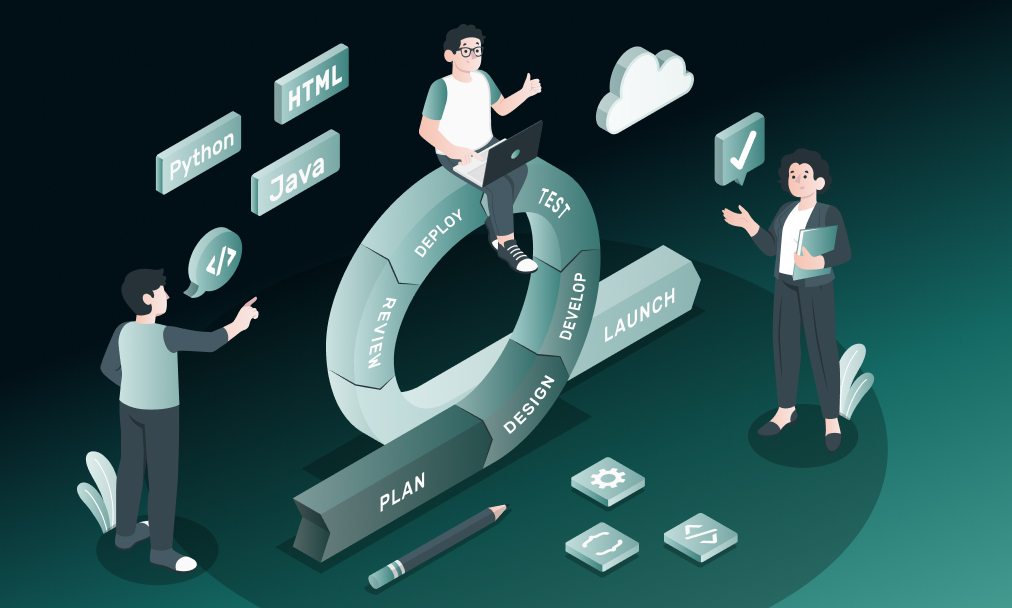From Low-Code to Full-Fledged Product
Belitsoft custom software development company notes that a project that used to require 1,000 development hours can be completed in 200 today. The low-code/no-code space is booming. Global low-code platform revenue jumped from under $8 billion in 2018 to an expected $32 billion in 2024, and analysts forecast the market will keep growing at 25–30%+ CAGR through 2028. This surge has attracted investors: for example, Bubble (a leading US-based no-code platform) closed a $100 million Series A led by Insight Partners in 2021.
Simultaneously, Gartner and EY predict that by 2025, low-code/no-code development will account for more than 70% of new business applications, indicating broad adoption among startups and corporations. Major tech companies are also backing the trend: Microsoft, Google, and other giants have embedded no-code tools into their clouds, and industry reports note that integration with AI is becoming a key feature of next-generation platforms. In North America and Europe, venture funding remains strong for low-code businesses even amid broader startup market fluctuations, buoyed by demand for faster innovation and a shortage of traditional developers.
Case Studies: From Prototype to Production
Many startups and enterprises have taken prototypes built on low-code platforms all the way to commercial launch. For example, Zurich Insurance’s UK team built a claims app in minutes with Mendix and delivered a full mobile solution to 2,000 fleet drivers in just four weeks.
In the US, a digital challenger bank adopted OutSystems and now uses it for dozens of apps – saving ~$1.8 million on one workflow and planning to migrate much of its core banking technology into the low-code platform.
Similarly, a Canadian IT security startup used Bubble to create a security-engineer marketplace MVP, demonstrating “remarkably short” time-to-market and low cost. These examples show how low-code prototypes can be rapidly iterated into production-grade software.
Other successful no/low-code launches include:
- Compound (UK) – An ecommerce automation service built largely with Zapier and no-code workflows, now at £165K/year, saving clients ~90% on manual processes.
- Locale.ai (USA) – Launched on no-code tooling, this location-analytics SaaS scaled to $650K annual recurring revenue, serving 33 countries.
- NotionForms (global) – A web form builder for Notion users, bootstrapped to 26K customers and ~$182K ARR, with no-code used extensively in its backend.
- Codemap.io (global) – A marketplace for no-code experts, which was itself built with no-code tools and has facilitated over $2M of client projects and 100+ hires in its first 6 months.
These case studies span the UK, US, and Canada and illustrate a common pattern: founders use low-code platforms (Bubble, Mendix, OutSystems, Zapier, etc.) to validate product ideas quickly, then progressively enhance or rewrite parts of the app as scale demands.
Technology Stacks
Once an app outgrows its initial low-code prototype, teams typically migrate to a traditional technology stack built on cloud infrastructure. Common components involve:
- Cloud Platforms & Services: Azure, Google Cloud, or AWS with managed services and containerization (Docker, Kubernetes) for scalability and dependability. For example, one migrated platform “swapped Bubble’s shared hosting for AWS” and achieved 40% lower hosting costs.
- Backend Frameworks: Languages like JavaScript/TypeScript (Node.js/Express), Python (FastAPI, Django/Flask), Java (Spring), or .NET/C#, depending on the team’s expertise. In a published migration case, the team rebuilt an AI transcription platform using Node.js and Python (FastAPI) services on the backend.
- Databases & Search: Scalable databases (PostgreSQL, MySQL, MongoDB, etc.) and search/indexing tools (Elasticsearch, Redis cache) are common for performance. In the case study above, the new stack included PostgreSQL and Elasticsearch for fast queries.
- Frontend: Modern JavaScript frameworks (React, Angular, Vue) or mobile frameworks are used for rich user interfaces. (Many initial no-code tools effectively generated React-like interfaces under the hood.) Some teams also add a headless CMS or custom admin UI (e.g., Strapi) for content management and internal tools.
- T/GraphQL APIs connect components; CI/CD pipelines automate testing and deployment. Docker/Kubernetes or serverless platforms ensure horizontal scaling.
In summary, scaling beyond no-code often means migrating to a cloud-native, microservice-oriented stack. These mature technologies give teams more control and can handle heavier loads, at the cost of longer development time. (Analysis shows a custom stack can pay off within a year when an app needs to serve many users.)
The Role of AI in the Transition
AI is playing a growing role in every stage of this process. On the low-code side, many platforms now include AI assistants and generation features. For example, Bubble offers AI model integration to add features, OutSystems advertises “AI-powered” development tools, and Mendix provides “AI Assisted Development” capabilities.
More broadly, AI tools like GitHub Copilot, OpenAI Codex/ChatGPT and similar assistants are used by founders and developers to speed up coding. They can auto-generate code snippets or workflows from high-level descriptions, effectively bridging the gap between no-code logic and custom code. Natural-language interfaces (in PowerApps, Google AppSheet, etc.) can even translate text requirements into UI logic.
AI also aids testing and optimization. Low-code platforms incorporate machine learning to automatically detect UI/UX issues or suggest performance improvements. Teams moving to full code similarly use AI-driven testing frameworks to catch bugs before deployment. Meanwhile, product teams use AI in prototyping (e.g., generating images or text via OpenAI in a Bubble app) and in analytics once the app is live. In practice, startup founders often use ChatGPT/GitHub Copilot as a “co-pilot” to write boilerplate code, fix integration bugs, or even draft data schemas when moving beyond no-code.
Overall, AI tools are accelerating the prototype-to-product journey. They let non-technical founders or small teams handle more complexity, and they streamline the rewrite from no-code to code. Industry surveys predict that by 2030, a majority of developers will routinely use AI-augmented and no-code tools together. In 2025, we see this trend unfolding: no-code creators leverage AI assistants during development, and enterprises adopt AI-powered features within low-code platforms to boost productivity.
Turning Low-Code Prototypes into Scalable Products: Challenges & Solutions (2025)
Low-code and no-code development have exploded into the mainstream. By 2025, roughly 65–80% of new business applications are expected to be built with low-code tools. This promises rapid prototyping and high ROI – for example, companies report 10× faster development and 58% average revenue gains from customer-facing low-code apps. However, moving a low-code MVP to a robust, market-ready product uncovers many challenges. In this part, we at Belitsoft examine the technical, business, and organizational hurdles – and how US, UK, and Canadian firms are addressing them.
Technical Challenges (Scalability, Security, Integration)
Scalability. Low-code platforms excel for small prototypes, but can falter under high load. Nearly 47% of IT leaders worry that low-code apps “may not scale well as the business grows”. Off-the-shelf low-code services often have fixed limits or shared resources. To overcome this, companies adopt enterprise-grade low-code tools or hybrid architectures. For example, Superblocks notes that enterprise low-code offerings now include CI/CD pipelines, multi-environment support, and elastic cloud deployments to handle thousands of users. In practice, companies often put high-throughput modules on scalable cloud services or microservices, while using low-code for the user-facing layer. As Cineplex (Canada) found, integrating Power Platform automations with Azure functions enabled 100+ employees to automate tasks without slowing down the system. Practical tip: Plan for scaling up front – use load testing, caching, and autoscaling. Ensure your platform supports horizontal scaling and can export custom code if needed.
Security & Compliance. A big concern is that citizen developers may focus on features over security. Tools like large-language-model assistants can help build apps, but they “often bypass seasoned developers” and can embed vulnerabilities. In fact, 25% of companies report security worries with low-code solutions. The solution is to bake in security from day one. Use platforms with built-in compliance features (ISO 27001, SOC2, GDPR, etc.) and configurable controls. Vendors now offer role-based access, single-sign-on, encryption, and audit logging as standard. For example, Quixy’s platform is ISO-27001 certified and provides multi-factor authentication, data encryption, and detailed audit logs. Teams should also adopt DevSecOps practices: run static analysis on generated code, do regular security reviews, and train citizen developers in best practices. The Government of Canada notes that tools like Zapier (no-code integration) allow secure, rule-based data flows between services – illustrating that even non-coders can apply structured security if guided.
Integration. Commercial products must link to legacy systems and external services. Integration is a headache: 68% of businesses still face low-code integration issues. A startup like Hesti (UK) had to merge dozens of public/private APIs (housing, climate data, mapping) into one app. Its founders struggled initially: “incorporating data layers from so many providers through their APIs has certainly been a challenge,” requiring them to develop prompt-engineering skills to make AI-assisted low-code connect diverse sources. Modern solutions: choose API-first platforms with rich connectors. Quixy, for example, emphasizes webhooks and pre-built API connectors for ERPs, CRMs, and the like. Superblocks stresses that enterprise low-code must support REST/GraphQL endpoints, direct SQL/NoSQL DB access, and robust API management. Generative AI tools are also emerging to auto-generate integration code or queries. In practice, teams often pair low-code flows with custom middleware: e.g. using Zapier or Make.com to orchestrate data, or deploying serverless functions as glue. As one report notes, vendors are actively improving “API management and connectivity solutions” to make integrations “accessible to non-technical users”.
Key Technical Takeaways: Build on platforms designed for enterprise use, not just prototyping. Plan for growth by leveraging cloud scalability and microservices. Enforce security and governance (RBAC, SSO, audits) from the start. Use API-focused low-code tools or add custom code for special cases. In short, treat the low-code prototype like any other codebase: maintain version control, perform load and security tests, and document its architecture.
Organizational Challenges (Team Structure, Hiring, Transition)
Team Structure. A balanced team is critical. Relying only on business users (citizen developers) can lead to shadow-IT, governance problems, and gaps in expertise. Likewise, a pure low-code team might lack deep technical skills to optimize and maintain the platform. As one analysis notes, an “inappropriate team” – e.g., missing a technical lead – is a top reason startups fail. Best practice is a fusion team: combine at least one or two seasoned developers or full-stack engineers with domain experts. The tech leads handle complex customizations, security, and system integrations, while other members use visual tools for rapid UI/logic assembly. Over time, promote cross-training: let developers mentor business folks on low-code best practices, and have business experts guide devs on product needs. Microsoft’s Fusion team concept (mentioned for Zurich) is a model: it brings “citizen and pro developers” together on one platform. Also, establish clear roles: product owners to gather requirements, QA specialists to test (low-code apps still need QA!), and DevOps/IT to oversee deployment and monitoring.
Hiring Technical Talent. Even with low-code, high-level technical talent is often needed. Developer salaries are steep (over $100k in the US, similar in Canada/UK). Low-code reduces the need to hire as many devs – one stat finds typical companies save ~$140–300k/year by not hiring 2 devs via no-code. Still, plan to eventually bring on or contract specialists: full-stack engineers can write custom modules where low-code falls short, and DevOps or security engineers can handle architecture and compliance. The shortage of programmers (69% of devs prefer low-code tools, but talent is still scarce) means recruiting should emphasize flexibility: look for developers with experience in both code and low-code platforms. Many teams also train existing staff. Surveys show that up to 85% of employees say no-code tools add real value, so investing in internal training (and certifying your team on the platform) pays off.
Transitioning from No-Code to Full-Stack. If you start with non-technical founders or a “no-code” MVP team, you’ll eventually need to transition to more robust engineering as the product matures. This isn’t easy: low-code platforms can create lock-in. Mitigate this by selecting tools that allow data portability and code export. For example, some platforms (like Retool or OutSystems) let you extract logic or integrate with Git-based source control. Plan your architecture with modularity: keep core business logic decoupled so it can be reimplemented in code if necessary. Quixy highlights vendor lock-in as a risk and suggests using open standards so you “maintain ownership and control of your data and integrations”. In practice, as a startup grows, it may phase in a custom codebase alongside the low-code system. Agile processes help here: devs can rewrite critical components iteratively. In parallel, keep the low-code team in the loop so that knowledge transfers.
Governance & Culture: Finally, manage “shadow IT” by establishing clear governance. Quixy warns that unguided citizen development can lead to compliance issues. Use role-based permissions and approval workflows so all new apps get basic security/governance checks. Encourage a culture of documentation and peer review even for visual builds. Maintain a central repository of templates and shared components to avoid duplication.
Business Challenges (Funding, Market Fit, Pricing)
Funding & Investment. Startups built on low-code can save on development burn, but still need funds for marketing, ops, and scaling. The good news: VCs are keen on no-code. In 2024, 40+ no-code/low-code startups raised major funding, including multi-hundred-million-dollar rounds (e.g., Builder.ai’s $100M). The massive ROI (average 362%) and fast payback (92% recovery in 1 year) of no-code projects help persuade investors. However, competition is fierce: overall startup funding is high (North American startups saw $145B in H1 2025), but VCs are choosy, especially favoring AI-enabled or vertical solutions. To secure funding, founders should demonstrate market traction quickly. Use low-code to spin up an MVP, test it with real customers, gather metrics (engagement, retention), and then pitch data. A strong business plan and product-market fit are essential for success, according to one VC analysis. Don’t rely on tech novelty alone. A low-code startup must also plan for self-sustaining growth.
Market Fit & Business Model. Many startups fail from “lack of market demand” or “no business model”. Low-code just gets you to a working product faster – you still need product-market fit. Teams should iterate on feedback: the agility of low-code lets them pivot features or target niches quickly. For example, Hesti (UK) built a geo-planning tool for sustainable housing. They used low-code+AI to churn through data, but still went through multiple user-feedback cycles in early 2024 before finalizing the product. Founders must also define how to monetize early. Will you charge per user, per feature set, or via subscription tiers? Pricing must balance covering costs and remaining attractive. In practice, many SaaS products use tiered or usage-based pricing. Specialized low-code platforms (like KovaionAI for SaaS) even include subscription management and multi-tenant billing features to ease this. The key is to align pricing with value: enterprises often accept higher fees if integration, support, or custom SLAs are included.
Pricing Strategy. Setting prices can make or break a low-code product. Industry reports advise value-based and tiered pricing: start with a free or low-cost tier to grow users, then upsell premium features or higher usage plans. For example, many website builders (a form of no-code SaaS) use feature-based tiers. Low-code vendors themselves often charge per-app or per-developer-month. Examine competitors: if building B2B SaaS, check what similar tools charge (per-seat, per API-call, flat license, etc.). Use surveys or A/B tests to gauge willingness-to-pay. Because development overhead is lower, you might undercut traditional software pricing – but be careful not to signal “cheap equals low quality.”
Case Studies: To put it practically, low-code apps can impress investors and consumers by providing a significant return on investment. After using Power Platform to automate workflows, Cineplex (Canada) was able to save millions. Nsure (US) used Power Automate AI bots to halve expenses and reduce manual insurance processing time by 60%. These success stories demonstrate efficiency and market fit: consumers are willing to pay for products that address actual problems (like time savings). Use this information when establishing price points or making a pitch to investors.
Conclusion
In 2025, low-code platforms are strong facilitators but not panaceas. Businesses in the US, UK, and Canada are realizing that creating a prototype requires just as much work as creating traditional software. A mixed team comprising business experts and seasoned developers should be invested in, enterprise-grade platforms with cloud scalability, security certifications, and rich connectors should be prioritized, and low-code apps should be treated like code with planning, testing, and version control. Companies that do this are very successful; for example, Nsure and Cineplex use low-code automations to drastically reduce time and expenses. The shift is being facilitated by ongoing trends, such as widespread citizen development and AI-assisted development. In the end, the 2025 data demonstrates that low-code is changing the way products are developed and is no longer only used for proof-of-concepts. Startups and businesses can transform their low-code concepts into complete, market-ready applications by tackling scalability, security, funding, and team challenges head-on.
About the Author:

Dmitry Baraishuk is a partner and Chief Innovation Officer at a software development company Belitsoft (a Noventiq company). He has been leading a department specializing in custom software development for 20 years. The department has hundreds of successful projects in AI software development, healthcare and finance IT consulting, application modernization, cloud migration, data analytics implementation, and more for startups and enterprises in the US, UK, and Canada.





























